Risk Perception and Communication: Exploring Theoretical Frameworks
VerifiedAdded on 2020/05/28
|14
|4100
|89
Essay
AI Summary
This essay delves into the multifaceted realm of risk perception and communication, examining various theoretical models and their real-world applications. It begins by defining risk and exploring the importance of understanding how individuals and groups perceive it. The essay then introduces key psychological and sociological models, including the Psychometric Paradigm and Cultural Theory, which offer different perspectives on how risk perceptions are formed and influenced by individual experiences, social contexts, and cultural backgrounds. Furthermore, the essay analyzes the impact of risk perception in the workplace, particularly in confined space environments, highlighting the significance of worker perceptions, the influence of fear, and the role of communication in mitigating risks. It discusses the relevance of theories such as Protection Motivation Theory and Cognitive Dissonance Theory in understanding and addressing risk-taking behaviors. Finally, the essay emphasizes the need for comprehensive programs and campaigns to raise awareness and promote safer practices within communities and workplaces. The provided context highlights the issues associated with confined space activities in the workplace and how risk perception can be related to Psychological and Sociological Theories.
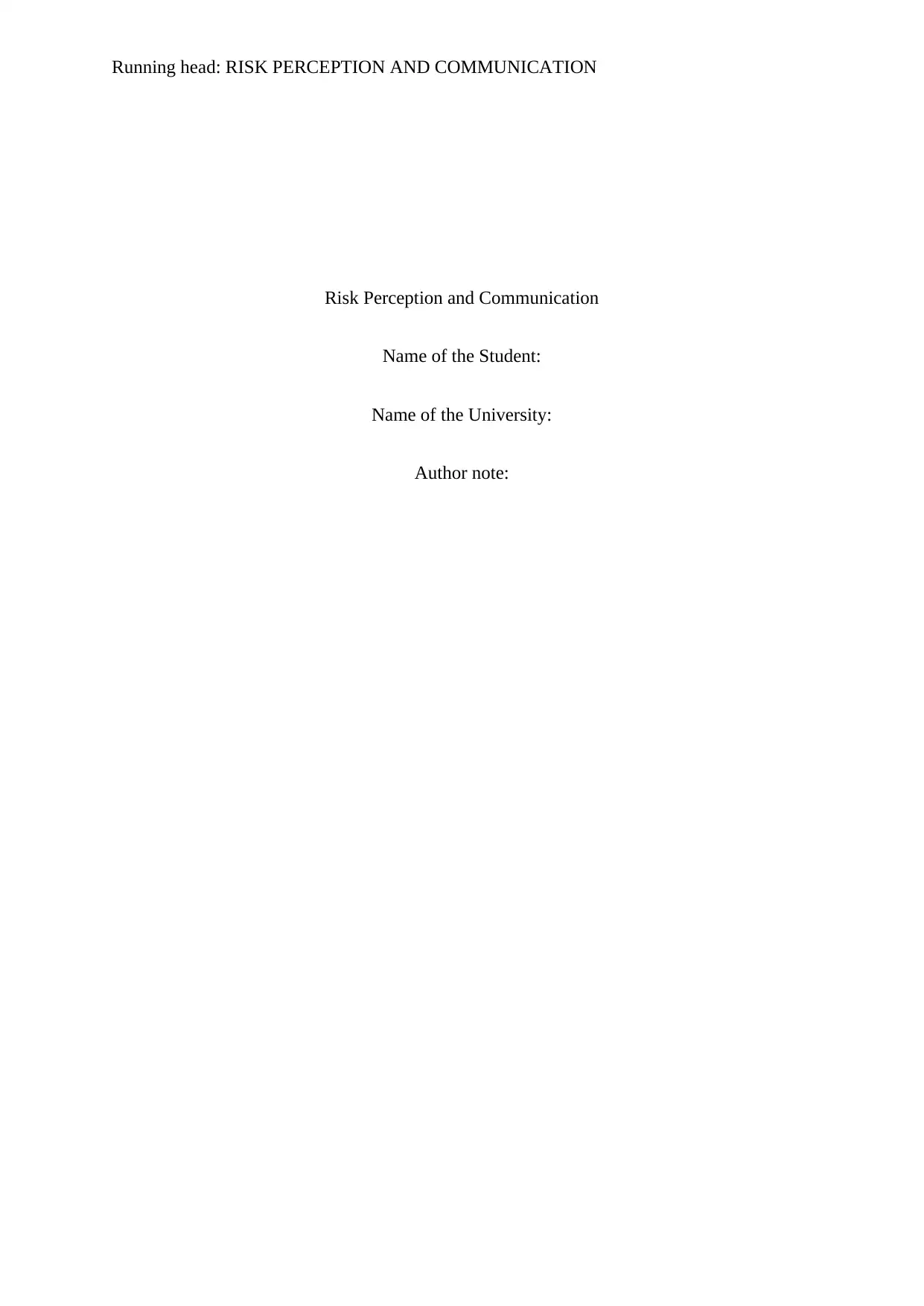
Running head: RISK PERCEPTION AND COMMUNICATION
Risk Perception and Communication
Name of the Student:
Name of the University:
Author note:
Risk Perception and Communication
Name of the Student:
Name of the University:
Author note:
Paraphrase This Document
Need a fresh take? Get an instant paraphrase of this document with our AI Paraphraser
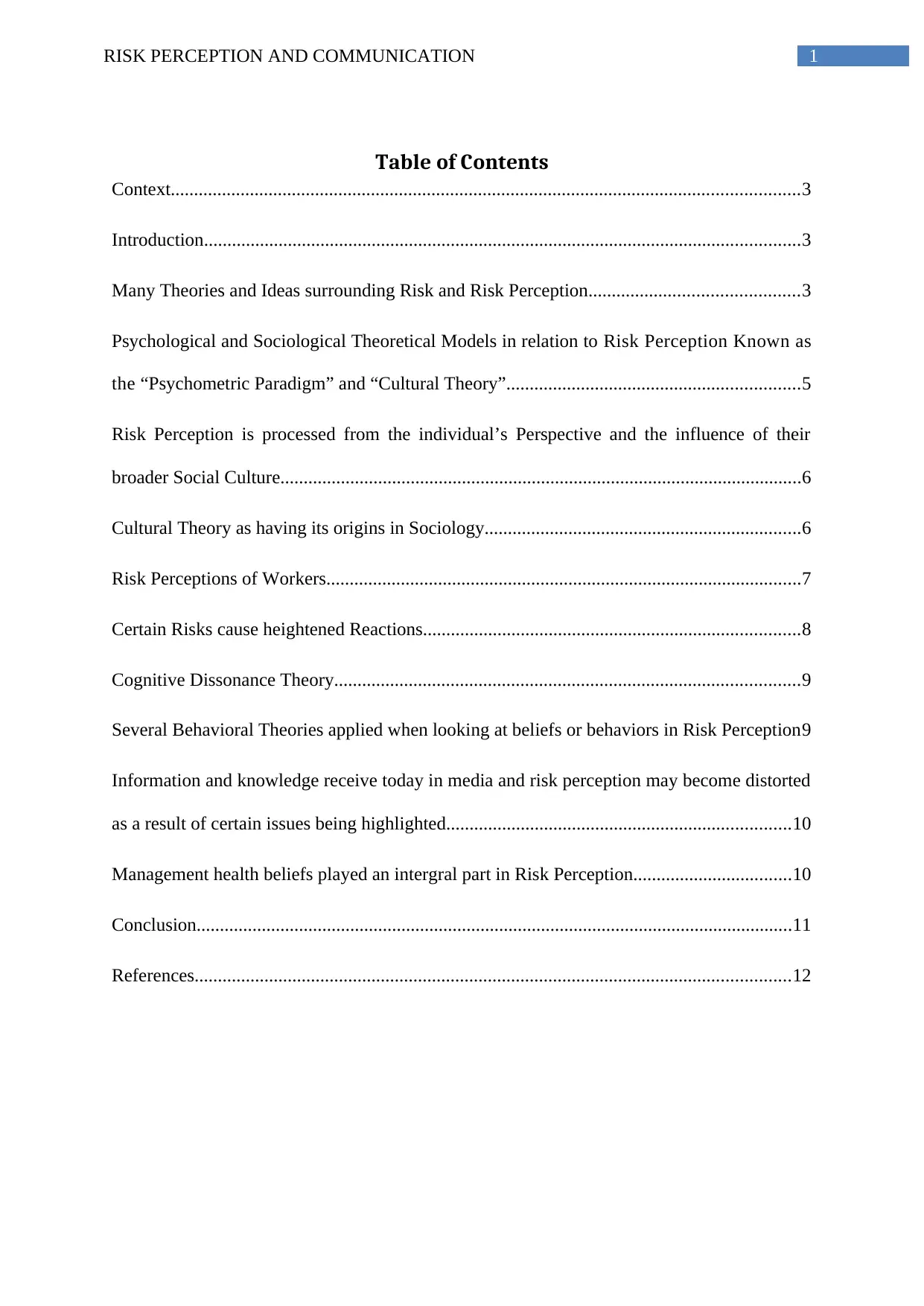
1RISK PERCEPTION AND COMMUNICATION
Table of Contents
Context.......................................................................................................................................3
Introduction................................................................................................................................3
Many Theories and Ideas surrounding Risk and Risk Perception.............................................3
Psychological and Sociological Theoretical Models in relation to Risk Perception Known as
the “Psychometric Paradigm” and “Cultural Theory”...............................................................5
Risk Perception is processed from the individual’s Perspective and the influence of their
broader Social Culture................................................................................................................6
Cultural Theory as having its origins in Sociology....................................................................6
Risk Perceptions of Workers......................................................................................................7
Certain Risks cause heightened Reactions.................................................................................8
Cognitive Dissonance Theory....................................................................................................9
Several Behavioral Theories applied when looking at beliefs or behaviors in Risk Perception9
Information and knowledge receive today in media and risk perception may become distorted
as a result of certain issues being highlighted..........................................................................10
Management health beliefs played an intergral part in Risk Perception..................................10
Conclusion................................................................................................................................11
References................................................................................................................................12
Table of Contents
Context.......................................................................................................................................3
Introduction................................................................................................................................3
Many Theories and Ideas surrounding Risk and Risk Perception.............................................3
Psychological and Sociological Theoretical Models in relation to Risk Perception Known as
the “Psychometric Paradigm” and “Cultural Theory”...............................................................5
Risk Perception is processed from the individual’s Perspective and the influence of their
broader Social Culture................................................................................................................6
Cultural Theory as having its origins in Sociology....................................................................6
Risk Perceptions of Workers......................................................................................................7
Certain Risks cause heightened Reactions.................................................................................8
Cognitive Dissonance Theory....................................................................................................9
Several Behavioral Theories applied when looking at beliefs or behaviors in Risk Perception9
Information and knowledge receive today in media and risk perception may become distorted
as a result of certain issues being highlighted..........................................................................10
Management health beliefs played an intergral part in Risk Perception..................................10
Conclusion................................................................................................................................11
References................................................................................................................................12
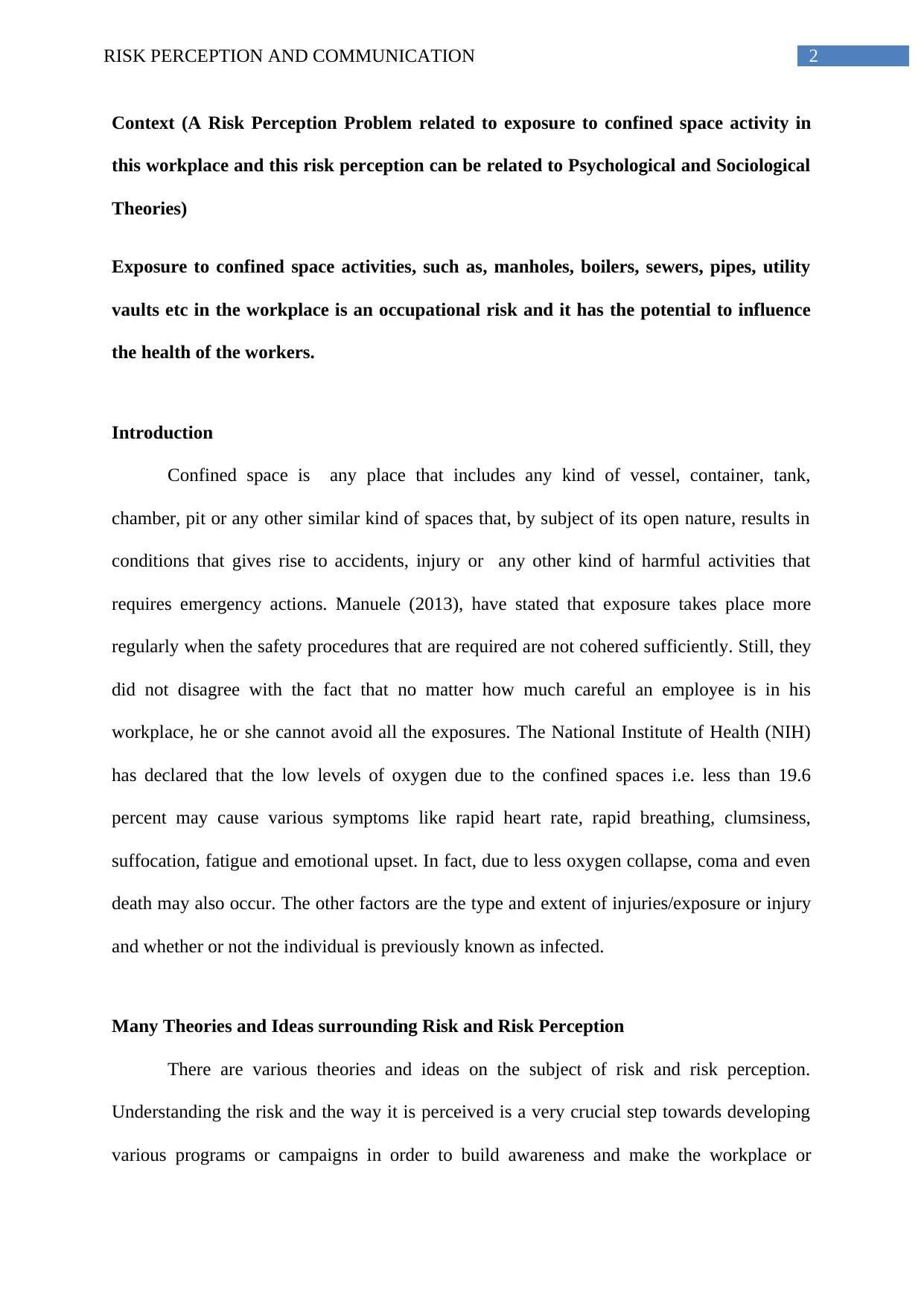
2RISK PERCEPTION AND COMMUNICATION
Context (A Risk Perception Problem related to exposure to confined space activity in
this workplace and this risk perception can be related to Psychological and Sociological
Theories)
Exposure to confined space activities, such as, manholes, boilers, sewers, pipes, utility
vaults etc in the workplace is an occupational risk and it has the potential to influence
the health of the workers.
Introduction
Confined space is any place that includes any kind of vessel, container, tank,
chamber, pit or any other similar kind of spaces that, by subject of its open nature, results in
conditions that gives rise to accidents, injury or any other kind of harmful activities that
requires emergency actions. Manuele (2013), have stated that exposure takes place more
regularly when the safety procedures that are required are not cohered sufficiently. Still, they
did not disagree with the fact that no matter how much careful an employee is in his
workplace, he or she cannot avoid all the exposures. The National Institute of Health (NIH)
has declared that the low levels of oxygen due to the confined spaces i.e. less than 19.6
percent may cause various symptoms like rapid heart rate, rapid breathing, clumsiness,
suffocation, fatigue and emotional upset. In fact, due to less oxygen collapse, coma and even
death may also occur. The other factors are the type and extent of injuries/exposure or injury
and whether or not the individual is previously known as infected.
Many Theories and Ideas surrounding Risk and Risk Perception
There are various theories and ideas on the subject of risk and risk perception.
Understanding the risk and the way it is perceived is a very crucial step towards developing
various programs or campaigns in order to build awareness and make the workplace or
Context (A Risk Perception Problem related to exposure to confined space activity in
this workplace and this risk perception can be related to Psychological and Sociological
Theories)
Exposure to confined space activities, such as, manholes, boilers, sewers, pipes, utility
vaults etc in the workplace is an occupational risk and it has the potential to influence
the health of the workers.
Introduction
Confined space is any place that includes any kind of vessel, container, tank,
chamber, pit or any other similar kind of spaces that, by subject of its open nature, results in
conditions that gives rise to accidents, injury or any other kind of harmful activities that
requires emergency actions. Manuele (2013), have stated that exposure takes place more
regularly when the safety procedures that are required are not cohered sufficiently. Still, they
did not disagree with the fact that no matter how much careful an employee is in his
workplace, he or she cannot avoid all the exposures. The National Institute of Health (NIH)
has declared that the low levels of oxygen due to the confined spaces i.e. less than 19.6
percent may cause various symptoms like rapid heart rate, rapid breathing, clumsiness,
suffocation, fatigue and emotional upset. In fact, due to less oxygen collapse, coma and even
death may also occur. The other factors are the type and extent of injuries/exposure or injury
and whether or not the individual is previously known as infected.
Many Theories and Ideas surrounding Risk and Risk Perception
There are various theories and ideas on the subject of risk and risk perception.
Understanding the risk and the way it is perceived is a very crucial step towards developing
various programs or campaigns in order to build awareness and make the workplace or
⊘ This is a preview!⊘
Do you want full access?
Subscribe today to unlock all pages.

Trusted by 1+ million students worldwide
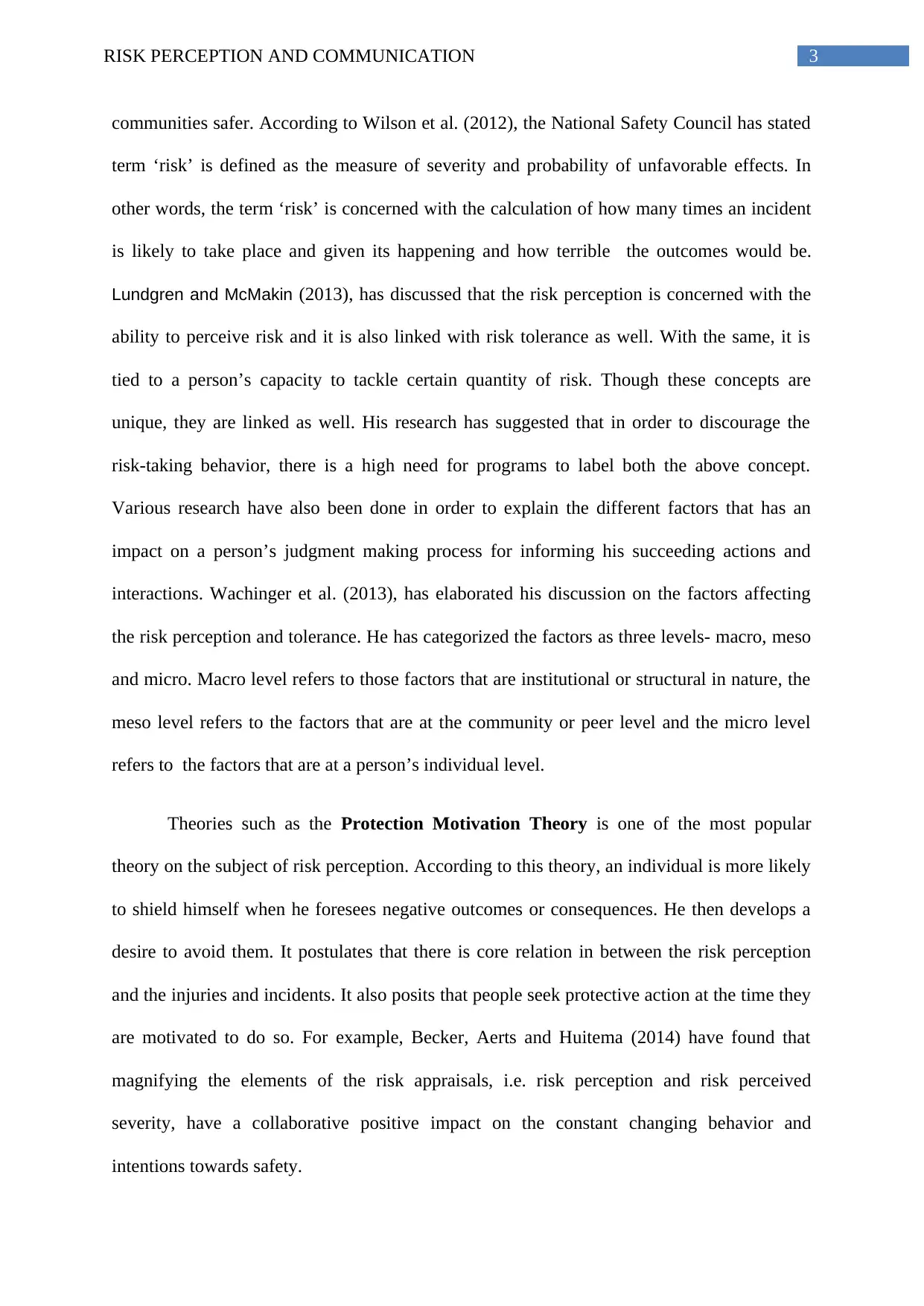
3RISK PERCEPTION AND COMMUNICATION
communities safer. According to Wilson et al. (2012), the National Safety Council has stated
term ‘risk’ is defined as the measure of severity and probability of unfavorable effects. In
other words, the term ‘risk’ is concerned with the calculation of how many times an incident
is likely to take place and given its happening and how terrible the outcomes would be.
Lundgren and McMakin (2013), has discussed that the risk perception is concerned with the
ability to perceive risk and it is also linked with risk tolerance as well. With the same, it is
tied to a person’s capacity to tackle certain quantity of risk. Though these concepts are
unique, they are linked as well. His research has suggested that in order to discourage the
risk-taking behavior, there is a high need for programs to label both the above concept.
Various research have also been done in order to explain the different factors that has an
impact on a person’s judgment making process for informing his succeeding actions and
interactions. Wachinger et al. (2013), has elaborated his discussion on the factors affecting
the risk perception and tolerance. He has categorized the factors as three levels- macro, meso
and micro. Macro level refers to those factors that are institutional or structural in nature, the
meso level refers to the factors that are at the community or peer level and the micro level
refers to the factors that are at a person’s individual level.
Theories such as the Protection Motivation Theory is one of the most popular
theory on the subject of risk perception. According to this theory, an individual is more likely
to shield himself when he foresees negative outcomes or consequences. He then develops a
desire to avoid them. It postulates that there is core relation in between the risk perception
and the injuries and incidents. It also posits that people seek protective action at the time they
are motivated to do so. For example, Becker, Aerts and Huitema (2014) have found that
magnifying the elements of the risk appraisals, i.e. risk perception and risk perceived
severity, have a collaborative positive impact on the constant changing behavior and
intentions towards safety.
communities safer. According to Wilson et al. (2012), the National Safety Council has stated
term ‘risk’ is defined as the measure of severity and probability of unfavorable effects. In
other words, the term ‘risk’ is concerned with the calculation of how many times an incident
is likely to take place and given its happening and how terrible the outcomes would be.
Lundgren and McMakin (2013), has discussed that the risk perception is concerned with the
ability to perceive risk and it is also linked with risk tolerance as well. With the same, it is
tied to a person’s capacity to tackle certain quantity of risk. Though these concepts are
unique, they are linked as well. His research has suggested that in order to discourage the
risk-taking behavior, there is a high need for programs to label both the above concept.
Various research have also been done in order to explain the different factors that has an
impact on a person’s judgment making process for informing his succeeding actions and
interactions. Wachinger et al. (2013), has elaborated his discussion on the factors affecting
the risk perception and tolerance. He has categorized the factors as three levels- macro, meso
and micro. Macro level refers to those factors that are institutional or structural in nature, the
meso level refers to the factors that are at the community or peer level and the micro level
refers to the factors that are at a person’s individual level.
Theories such as the Protection Motivation Theory is one of the most popular
theory on the subject of risk perception. According to this theory, an individual is more likely
to shield himself when he foresees negative outcomes or consequences. He then develops a
desire to avoid them. It postulates that there is core relation in between the risk perception
and the injuries and incidents. It also posits that people seek protective action at the time they
are motivated to do so. For example, Becker, Aerts and Huitema (2014) have found that
magnifying the elements of the risk appraisals, i.e. risk perception and risk perceived
severity, have a collaborative positive impact on the constant changing behavior and
intentions towards safety.
Paraphrase This Document
Need a fresh take? Get an instant paraphrase of this document with our AI Paraphraser
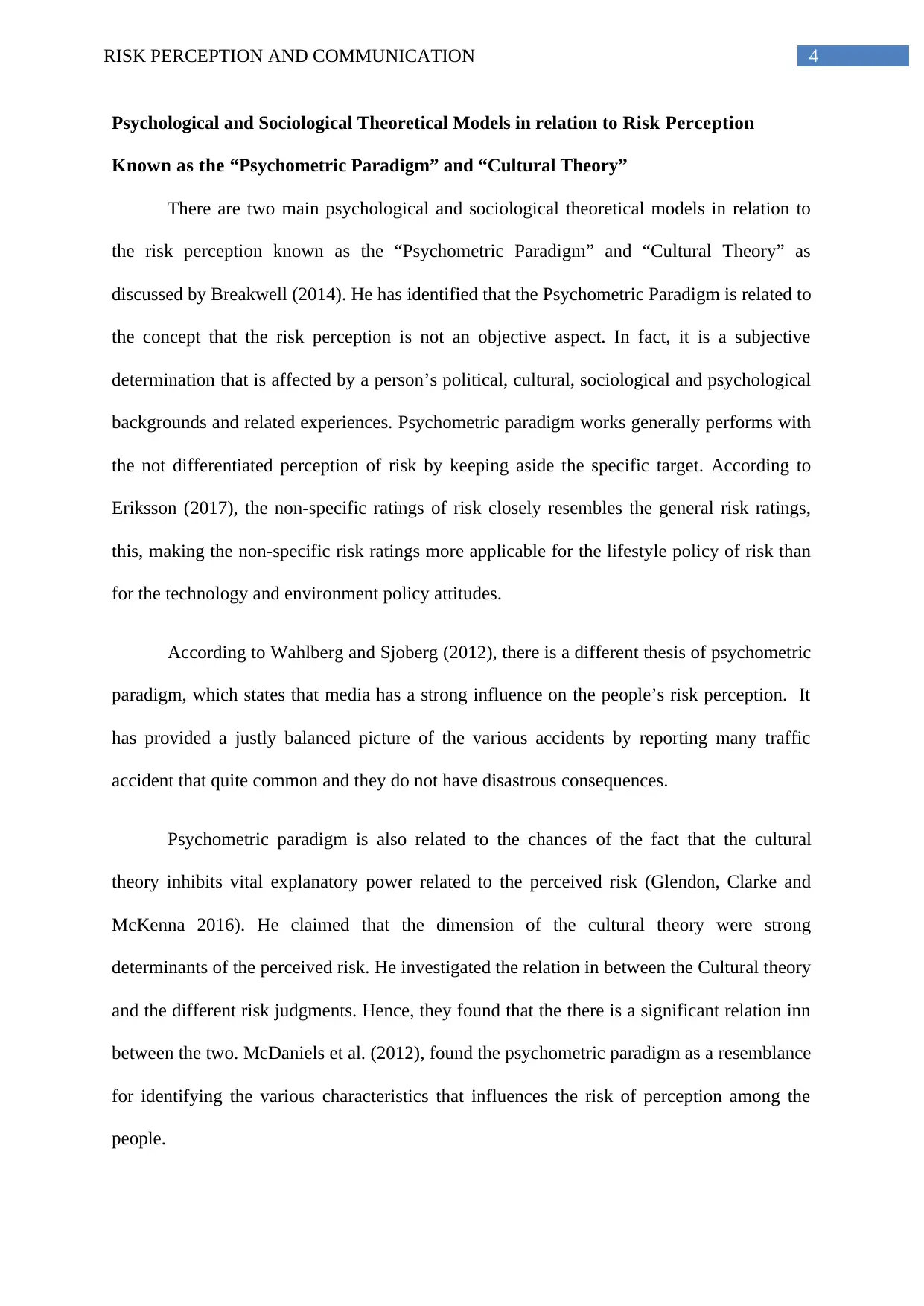
4RISK PERCEPTION AND COMMUNICATION
Psychological and Sociological Theoretical Models in relation to Risk Perception
Known as the “Psychometric Paradigm” and “Cultural Theory”
There are two main psychological and sociological theoretical models in relation to
the risk perception known as the “Psychometric Paradigm” and “Cultural Theory” as
discussed by Breakwell (2014). He has identified that the Psychometric Paradigm is related to
the concept that the risk perception is not an objective aspect. In fact, it is a subjective
determination that is affected by a person’s political, cultural, sociological and psychological
backgrounds and related experiences. Psychometric paradigm works generally performs with
the not differentiated perception of risk by keeping aside the specific target. According to
Eriksson (2017), the non-specific ratings of risk closely resembles the general risk ratings,
this, making the non-specific risk ratings more applicable for the lifestyle policy of risk than
for the technology and environment policy attitudes.
According to Wahlberg and Sjoberg (2012), there is a different thesis of psychometric
paradigm, which states that media has a strong influence on the people’s risk perception. It
has provided a justly balanced picture of the various accidents by reporting many traffic
accident that quite common and they do not have disastrous consequences.
Psychometric paradigm is also related to the chances of the fact that the cultural
theory inhibits vital explanatory power related to the perceived risk (Glendon, Clarke and
McKenna 2016). He claimed that the dimension of the cultural theory were strong
determinants of the perceived risk. He investigated the relation in between the Cultural theory
and the different risk judgments. Hence, they found that the there is a significant relation inn
between the two. McDaniels et al. (2012), found the psychometric paradigm as a resemblance
for identifying the various characteristics that influences the risk of perception among the
people.
Psychological and Sociological Theoretical Models in relation to Risk Perception
Known as the “Psychometric Paradigm” and “Cultural Theory”
There are two main psychological and sociological theoretical models in relation to
the risk perception known as the “Psychometric Paradigm” and “Cultural Theory” as
discussed by Breakwell (2014). He has identified that the Psychometric Paradigm is related to
the concept that the risk perception is not an objective aspect. In fact, it is a subjective
determination that is affected by a person’s political, cultural, sociological and psychological
backgrounds and related experiences. Psychometric paradigm works generally performs with
the not differentiated perception of risk by keeping aside the specific target. According to
Eriksson (2017), the non-specific ratings of risk closely resembles the general risk ratings,
this, making the non-specific risk ratings more applicable for the lifestyle policy of risk than
for the technology and environment policy attitudes.
According to Wahlberg and Sjoberg (2012), there is a different thesis of psychometric
paradigm, which states that media has a strong influence on the people’s risk perception. It
has provided a justly balanced picture of the various accidents by reporting many traffic
accident that quite common and they do not have disastrous consequences.
Psychometric paradigm is also related to the chances of the fact that the cultural
theory inhibits vital explanatory power related to the perceived risk (Glendon, Clarke and
McKenna 2016). He claimed that the dimension of the cultural theory were strong
determinants of the perceived risk. He investigated the relation in between the Cultural theory
and the different risk judgments. Hence, they found that the there is a significant relation inn
between the two. McDaniels et al. (2012), found the psychometric paradigm as a resemblance
for identifying the various characteristics that influences the risk of perception among the
people.
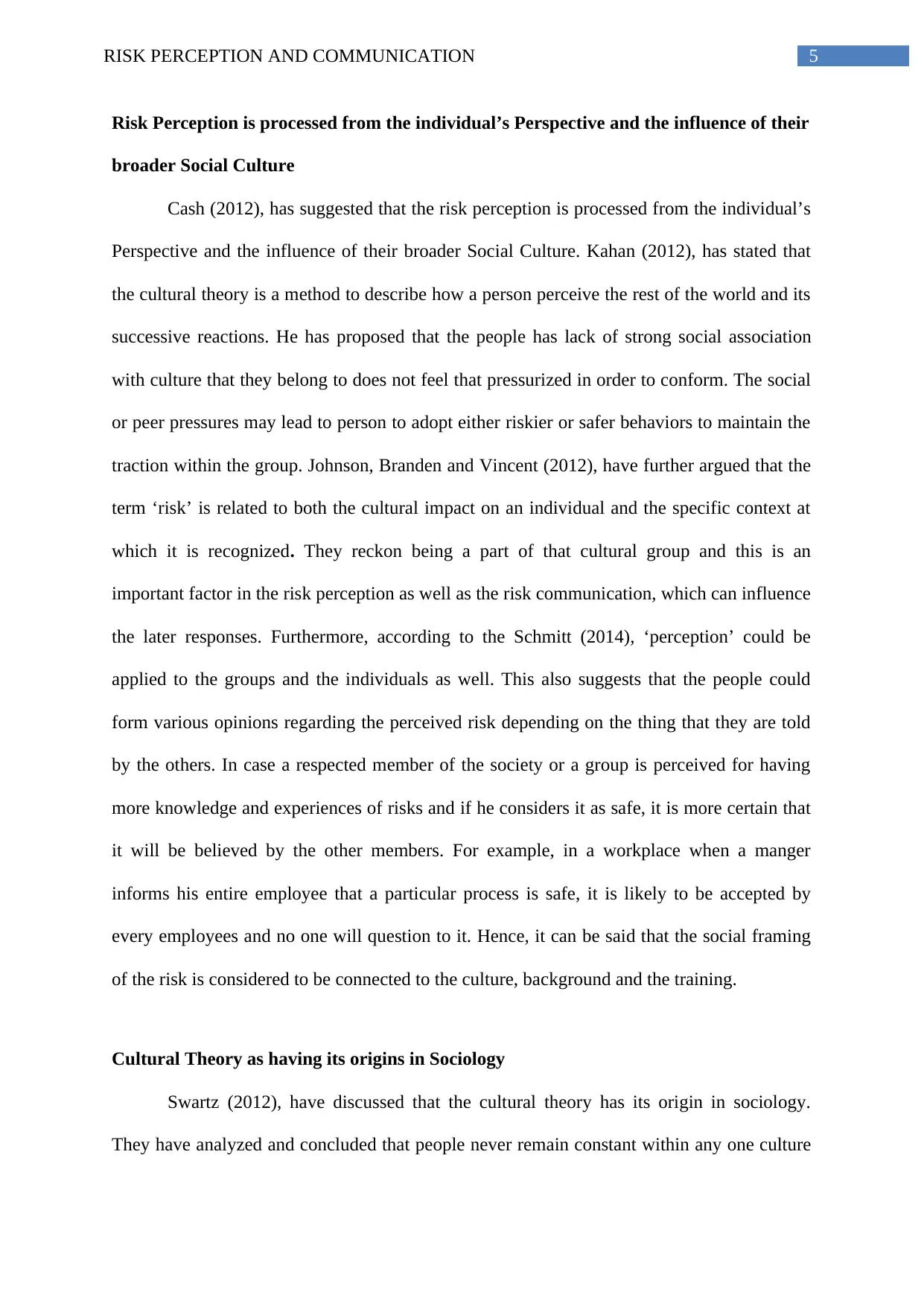
5RISK PERCEPTION AND COMMUNICATION
Risk Perception is processed from the individual’s Perspective and the influence of their
broader Social Culture
Cash (2012), has suggested that the risk perception is processed from the individual’s
Perspective and the influence of their broader Social Culture. Kahan (2012), has stated that
the cultural theory is a method to describe how a person perceive the rest of the world and its
successive reactions. He has proposed that the people has lack of strong social association
with culture that they belong to does not feel that pressurized in order to conform. The social
or peer pressures may lead to person to adopt either riskier or safer behaviors to maintain the
traction within the group. Johnson, Branden and Vincent (2012), have further argued that the
term ‘risk’ is related to both the cultural impact on an individual and the specific context at
which it is recognized. They reckon being a part of that cultural group and this is an
important factor in the risk perception as well as the risk communication, which can influence
the later responses. Furthermore, according to the Schmitt (2014), ‘perception’ could be
applied to the groups and the individuals as well. This also suggests that the people could
form various opinions regarding the perceived risk depending on the thing that they are told
by the others. In case a respected member of the society or a group is perceived for having
more knowledge and experiences of risks and if he considers it as safe, it is more certain that
it will be believed by the other members. For example, in a workplace when a manger
informs his entire employee that a particular process is safe, it is likely to be accepted by
every employees and no one will question to it. Hence, it can be said that the social framing
of the risk is considered to be connected to the culture, background and the training.
Cultural Theory as having its origins in Sociology
Swartz (2012), have discussed that the cultural theory has its origin in sociology.
They have analyzed and concluded that people never remain constant within any one culture
Risk Perception is processed from the individual’s Perspective and the influence of their
broader Social Culture
Cash (2012), has suggested that the risk perception is processed from the individual’s
Perspective and the influence of their broader Social Culture. Kahan (2012), has stated that
the cultural theory is a method to describe how a person perceive the rest of the world and its
successive reactions. He has proposed that the people has lack of strong social association
with culture that they belong to does not feel that pressurized in order to conform. The social
or peer pressures may lead to person to adopt either riskier or safer behaviors to maintain the
traction within the group. Johnson, Branden and Vincent (2012), have further argued that the
term ‘risk’ is related to both the cultural impact on an individual and the specific context at
which it is recognized. They reckon being a part of that cultural group and this is an
important factor in the risk perception as well as the risk communication, which can influence
the later responses. Furthermore, according to the Schmitt (2014), ‘perception’ could be
applied to the groups and the individuals as well. This also suggests that the people could
form various opinions regarding the perceived risk depending on the thing that they are told
by the others. In case a respected member of the society or a group is perceived for having
more knowledge and experiences of risks and if he considers it as safe, it is more certain that
it will be believed by the other members. For example, in a workplace when a manger
informs his entire employee that a particular process is safe, it is likely to be accepted by
every employees and no one will question to it. Hence, it can be said that the social framing
of the risk is considered to be connected to the culture, background and the training.
Cultural Theory as having its origins in Sociology
Swartz (2012), have discussed that the cultural theory has its origin in sociology.
They have analyzed and concluded that people never remain constant within any one culture
⊘ This is a preview!⊘
Do you want full access?
Subscribe today to unlock all pages.

Trusted by 1+ million students worldwide
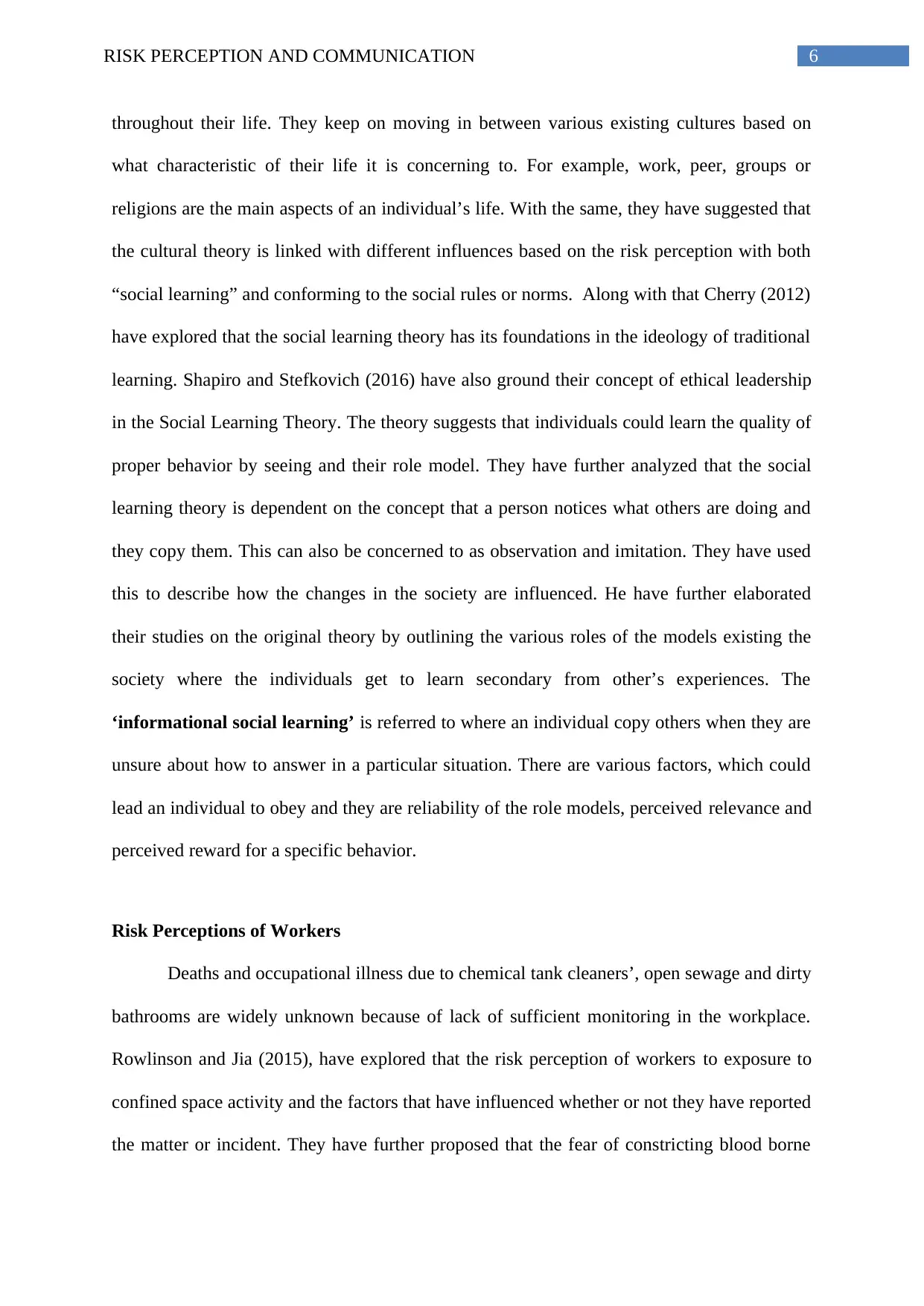
6RISK PERCEPTION AND COMMUNICATION
throughout their life. They keep on moving in between various existing cultures based on
what characteristic of their life it is concerning to. For example, work, peer, groups or
religions are the main aspects of an individual’s life. With the same, they have suggested that
the cultural theory is linked with different influences based on the risk perception with both
“social learning” and conforming to the social rules or norms. Along with that Cherry (2012)
have explored that the social learning theory has its foundations in the ideology of traditional
learning. Shapiro and Stefkovich (2016) have also ground their concept of ethical leadership
in the Social Learning Theory. The theory suggests that individuals could learn the quality of
proper behavior by seeing and their role model. They have further analyzed that the social
learning theory is dependent on the concept that a person notices what others are doing and
they copy them. This can also be concerned to as observation and imitation. They have used
this to describe how the changes in the society are influenced. He have further elaborated
their studies on the original theory by outlining the various roles of the models existing the
society where the individuals get to learn secondary from other’s experiences. The
‘informational social learning’ is referred to where an individual copy others when they are
unsure about how to answer in a particular situation. There are various factors, which could
lead an individual to obey and they are reliability of the role models, perceived relevance and
perceived reward for a specific behavior.
Risk Perceptions of Workers
Deaths and occupational illness due to chemical tank cleaners’, open sewage and dirty
bathrooms are widely unknown because of lack of sufficient monitoring in the workplace.
Rowlinson and Jia (2015), have explored that the risk perception of workers to exposure to
confined space activity and the factors that have influenced whether or not they have reported
the matter or incident. They have further proposed that the fear of constricting blood borne
throughout their life. They keep on moving in between various existing cultures based on
what characteristic of their life it is concerning to. For example, work, peer, groups or
religions are the main aspects of an individual’s life. With the same, they have suggested that
the cultural theory is linked with different influences based on the risk perception with both
“social learning” and conforming to the social rules or norms. Along with that Cherry (2012)
have explored that the social learning theory has its foundations in the ideology of traditional
learning. Shapiro and Stefkovich (2016) have also ground their concept of ethical leadership
in the Social Learning Theory. The theory suggests that individuals could learn the quality of
proper behavior by seeing and their role model. They have further analyzed that the social
learning theory is dependent on the concept that a person notices what others are doing and
they copy them. This can also be concerned to as observation and imitation. They have used
this to describe how the changes in the society are influenced. He have further elaborated
their studies on the original theory by outlining the various roles of the models existing the
society where the individuals get to learn secondary from other’s experiences. The
‘informational social learning’ is referred to where an individual copy others when they are
unsure about how to answer in a particular situation. There are various factors, which could
lead an individual to obey and they are reliability of the role models, perceived relevance and
perceived reward for a specific behavior.
Risk Perceptions of Workers
Deaths and occupational illness due to chemical tank cleaners’, open sewage and dirty
bathrooms are widely unknown because of lack of sufficient monitoring in the workplace.
Rowlinson and Jia (2015), have explored that the risk perception of workers to exposure to
confined space activity and the factors that have influenced whether or not they have reported
the matter or incident. They have further proposed that the fear of constricting blood borne
Paraphrase This Document
Need a fresh take? Get an instant paraphrase of this document with our AI Paraphraser
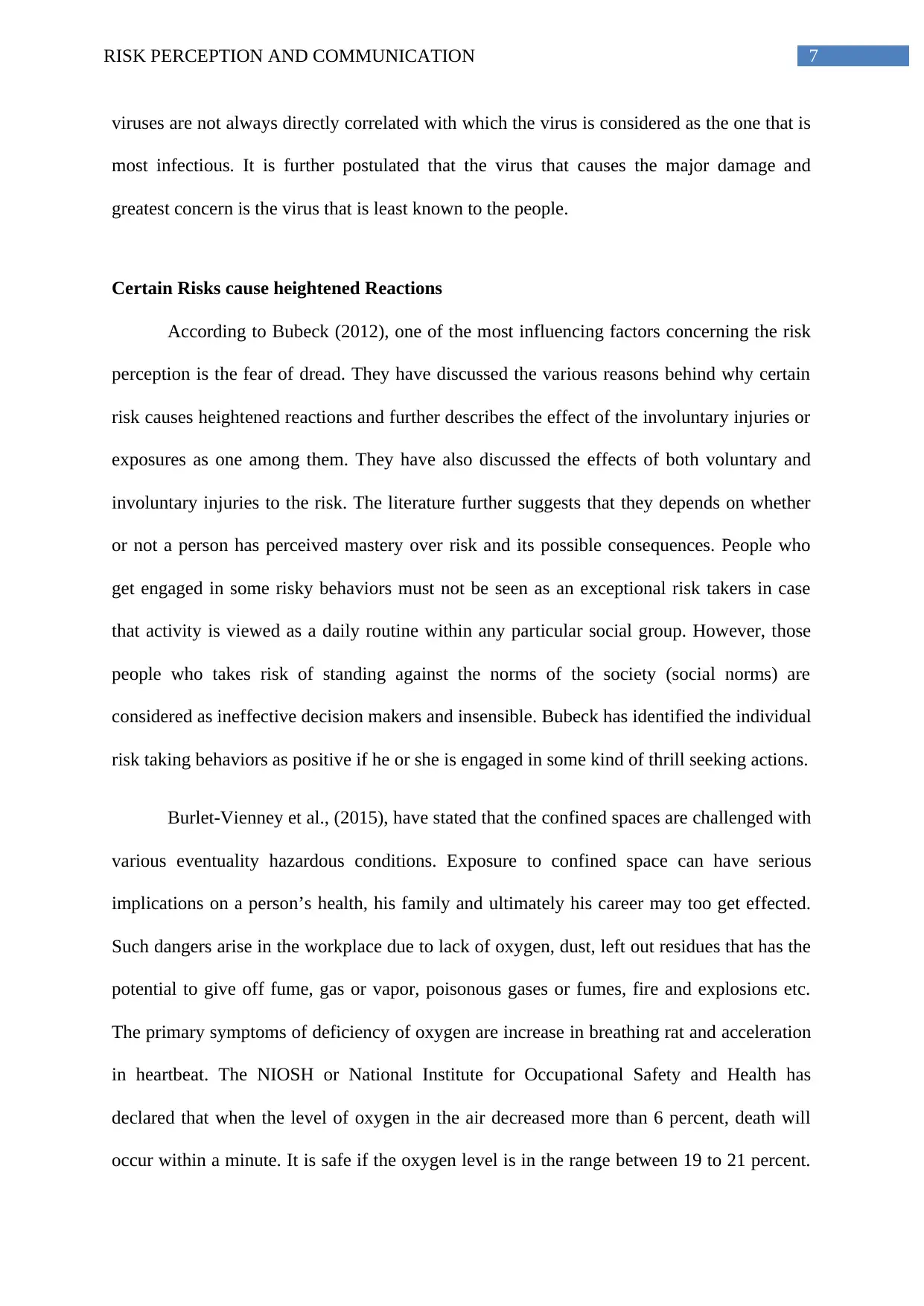
7RISK PERCEPTION AND COMMUNICATION
viruses are not always directly correlated with which the virus is considered as the one that is
most infectious. It is further postulated that the virus that causes the major damage and
greatest concern is the virus that is least known to the people.
Certain Risks cause heightened Reactions
According to Bubeck (2012), one of the most influencing factors concerning the risk
perception is the fear of dread. They have discussed the various reasons behind why certain
risk causes heightened reactions and further describes the effect of the involuntary injuries or
exposures as one among them. They have also discussed the effects of both voluntary and
involuntary injuries to the risk. The literature further suggests that they depends on whether
or not a person has perceived mastery over risk and its possible consequences. People who
get engaged in some risky behaviors must not be seen as an exceptional risk takers in case
that activity is viewed as a daily routine within any particular social group. However, those
people who takes risk of standing against the norms of the society (social norms) are
considered as ineffective decision makers and insensible. Bubeck has identified the individual
risk taking behaviors as positive if he or she is engaged in some kind of thrill seeking actions.
Burlet-Vienney et al., (2015), have stated that the confined spaces are challenged with
various eventuality hazardous conditions. Exposure to confined space can have serious
implications on a person’s health, his family and ultimately his career may too get effected.
Such dangers arise in the workplace due to lack of oxygen, dust, left out residues that has the
potential to give off fume, gas or vapor, poisonous gases or fumes, fire and explosions etc.
The primary symptoms of deficiency of oxygen are increase in breathing rat and acceleration
in heartbeat. The NIOSH or National Institute for Occupational Safety and Health has
declared that when the level of oxygen in the air decreased more than 6 percent, death will
occur within a minute. It is safe if the oxygen level is in the range between 19 to 21 percent.
viruses are not always directly correlated with which the virus is considered as the one that is
most infectious. It is further postulated that the virus that causes the major damage and
greatest concern is the virus that is least known to the people.
Certain Risks cause heightened Reactions
According to Bubeck (2012), one of the most influencing factors concerning the risk
perception is the fear of dread. They have discussed the various reasons behind why certain
risk causes heightened reactions and further describes the effect of the involuntary injuries or
exposures as one among them. They have also discussed the effects of both voluntary and
involuntary injuries to the risk. The literature further suggests that they depends on whether
or not a person has perceived mastery over risk and its possible consequences. People who
get engaged in some risky behaviors must not be seen as an exceptional risk takers in case
that activity is viewed as a daily routine within any particular social group. However, those
people who takes risk of standing against the norms of the society (social norms) are
considered as ineffective decision makers and insensible. Bubeck has identified the individual
risk taking behaviors as positive if he or she is engaged in some kind of thrill seeking actions.
Burlet-Vienney et al., (2015), have stated that the confined spaces are challenged with
various eventuality hazardous conditions. Exposure to confined space can have serious
implications on a person’s health, his family and ultimately his career may too get effected.
Such dangers arise in the workplace due to lack of oxygen, dust, left out residues that has the
potential to give off fume, gas or vapor, poisonous gases or fumes, fire and explosions etc.
The primary symptoms of deficiency of oxygen are increase in breathing rat and acceleration
in heartbeat. The NIOSH or National Institute for Occupational Safety and Health has
declared that when the level of oxygen in the air decreased more than 6 percent, death will
occur within a minute. It is safe if the oxygen level is in the range between 19 to 21 percent.
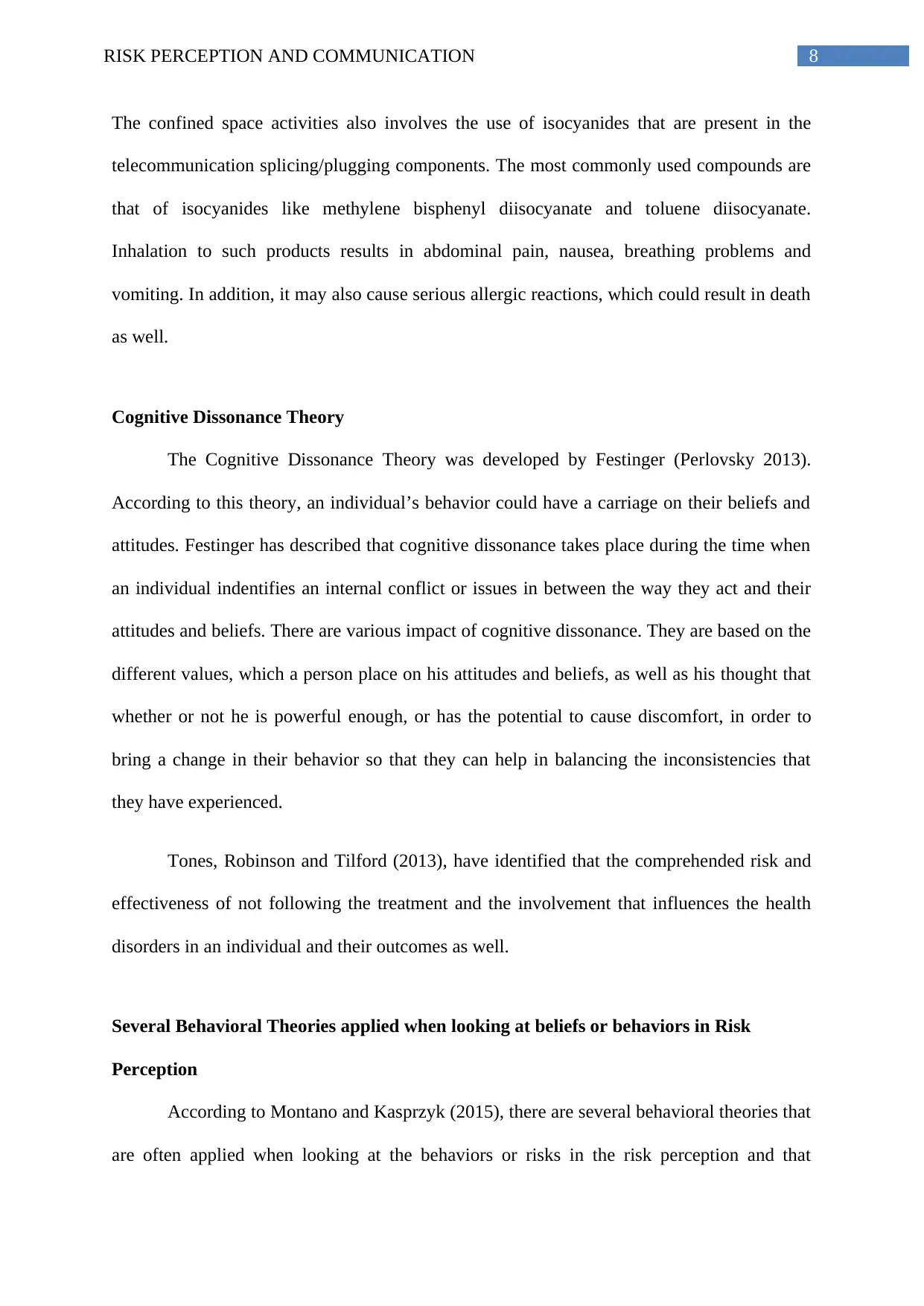
8RISK PERCEPTION AND COMMUNICATION
The confined space activities also involves the use of isocyanides that are present in the
telecommunication splicing/plugging components. The most commonly used compounds are
that of isocyanides like methylene bisphenyl diisocyanate and toluene diisocyanate.
Inhalation to such products results in abdominal pain, nausea, breathing problems and
vomiting. In addition, it may also cause serious allergic reactions, which could result in death
as well.
Cognitive Dissonance Theory
The Cognitive Dissonance Theory was developed by Festinger (Perlovsky 2013).
According to this theory, an individual’s behavior could have a carriage on their beliefs and
attitudes. Festinger has described that cognitive dissonance takes place during the time when
an individual indentifies an internal conflict or issues in between the way they act and their
attitudes and beliefs. There are various impact of cognitive dissonance. They are based on the
different values, which a person place on his attitudes and beliefs, as well as his thought that
whether or not he is powerful enough, or has the potential to cause discomfort, in order to
bring a change in their behavior so that they can help in balancing the inconsistencies that
they have experienced.
Tones, Robinson and Tilford (2013), have identified that the comprehended risk and
effectiveness of not following the treatment and the involvement that influences the health
disorders in an individual and their outcomes as well.
Several Behavioral Theories applied when looking at beliefs or behaviors in Risk
Perception
According to Montano and Kasprzyk (2015), there are several behavioral theories that
are often applied when looking at the behaviors or risks in the risk perception and that
The confined space activities also involves the use of isocyanides that are present in the
telecommunication splicing/plugging components. The most commonly used compounds are
that of isocyanides like methylene bisphenyl diisocyanate and toluene diisocyanate.
Inhalation to such products results in abdominal pain, nausea, breathing problems and
vomiting. In addition, it may also cause serious allergic reactions, which could result in death
as well.
Cognitive Dissonance Theory
The Cognitive Dissonance Theory was developed by Festinger (Perlovsky 2013).
According to this theory, an individual’s behavior could have a carriage on their beliefs and
attitudes. Festinger has described that cognitive dissonance takes place during the time when
an individual indentifies an internal conflict or issues in between the way they act and their
attitudes and beliefs. There are various impact of cognitive dissonance. They are based on the
different values, which a person place on his attitudes and beliefs, as well as his thought that
whether or not he is powerful enough, or has the potential to cause discomfort, in order to
bring a change in their behavior so that they can help in balancing the inconsistencies that
they have experienced.
Tones, Robinson and Tilford (2013), have identified that the comprehended risk and
effectiveness of not following the treatment and the involvement that influences the health
disorders in an individual and their outcomes as well.
Several Behavioral Theories applied when looking at beliefs or behaviors in Risk
Perception
According to Montano and Kasprzyk (2015), there are several behavioral theories that
are often applied when looking at the behaviors or risks in the risk perception and that
⊘ This is a preview!⊘
Do you want full access?
Subscribe today to unlock all pages.

Trusted by 1+ million students worldwide
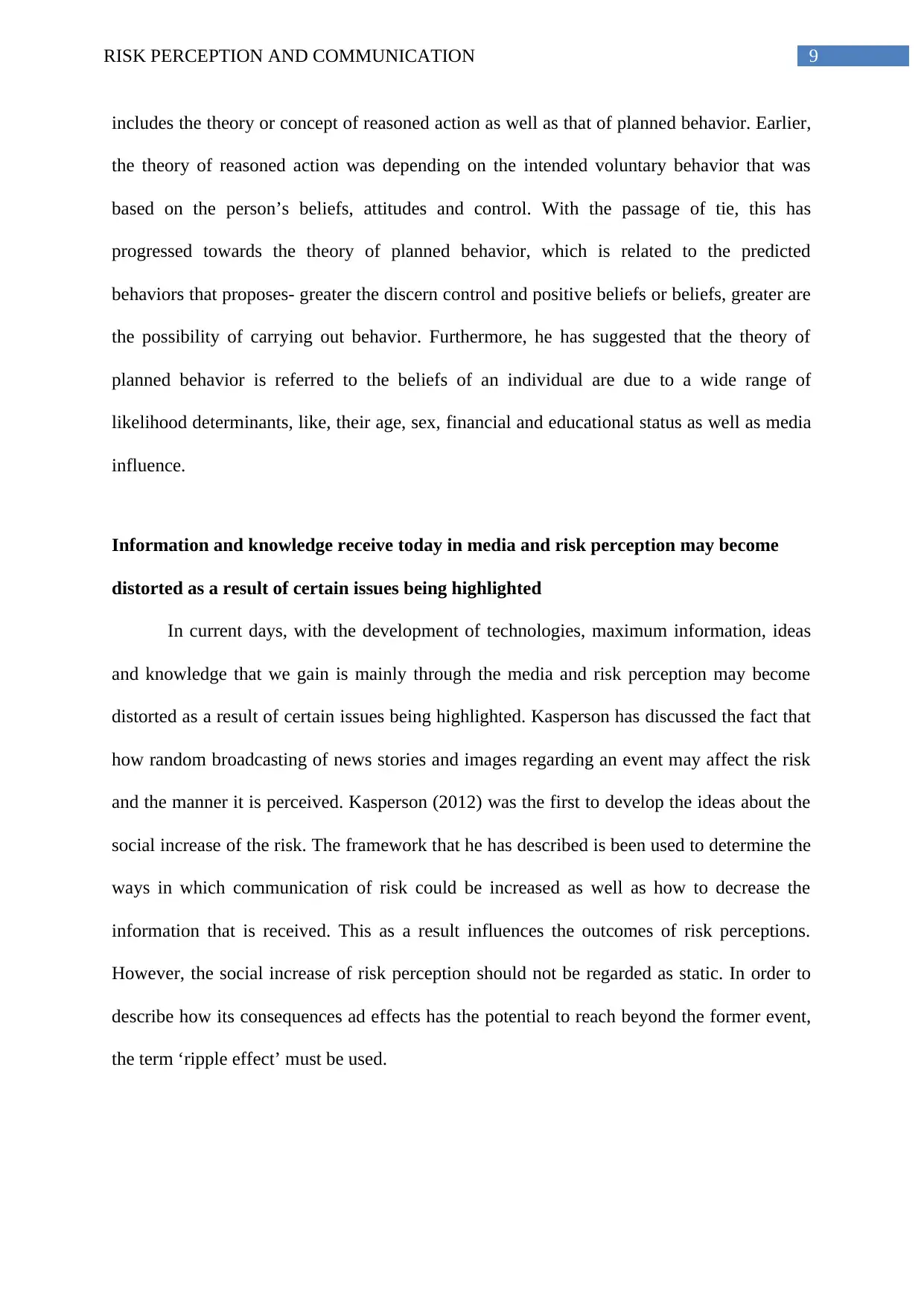
9RISK PERCEPTION AND COMMUNICATION
includes the theory or concept of reasoned action as well as that of planned behavior. Earlier,
the theory of reasoned action was depending on the intended voluntary behavior that was
based on the person’s beliefs, attitudes and control. With the passage of tie, this has
progressed towards the theory of planned behavior, which is related to the predicted
behaviors that proposes- greater the discern control and positive beliefs or beliefs, greater are
the possibility of carrying out behavior. Furthermore, he has suggested that the theory of
planned behavior is referred to the beliefs of an individual are due to a wide range of
likelihood determinants, like, their age, sex, financial and educational status as well as media
influence.
Information and knowledge receive today in media and risk perception may become
distorted as a result of certain issues being highlighted
In current days, with the development of technologies, maximum information, ideas
and knowledge that we gain is mainly through the media and risk perception may become
distorted as a result of certain issues being highlighted. Kasperson has discussed the fact that
how random broadcasting of news stories and images regarding an event may affect the risk
and the manner it is perceived. Kasperson (2012) was the first to develop the ideas about the
social increase of the risk. The framework that he has described is been used to determine the
ways in which communication of risk could be increased as well as how to decrease the
information that is received. This as a result influences the outcomes of risk perceptions.
However, the social increase of risk perception should not be regarded as static. In order to
describe how its consequences ad effects has the potential to reach beyond the former event,
the term ‘ripple effect’ must be used.
includes the theory or concept of reasoned action as well as that of planned behavior. Earlier,
the theory of reasoned action was depending on the intended voluntary behavior that was
based on the person’s beliefs, attitudes and control. With the passage of tie, this has
progressed towards the theory of planned behavior, which is related to the predicted
behaviors that proposes- greater the discern control and positive beliefs or beliefs, greater are
the possibility of carrying out behavior. Furthermore, he has suggested that the theory of
planned behavior is referred to the beliefs of an individual are due to a wide range of
likelihood determinants, like, their age, sex, financial and educational status as well as media
influence.
Information and knowledge receive today in media and risk perception may become
distorted as a result of certain issues being highlighted
In current days, with the development of technologies, maximum information, ideas
and knowledge that we gain is mainly through the media and risk perception may become
distorted as a result of certain issues being highlighted. Kasperson has discussed the fact that
how random broadcasting of news stories and images regarding an event may affect the risk
and the manner it is perceived. Kasperson (2012) was the first to develop the ideas about the
social increase of the risk. The framework that he has described is been used to determine the
ways in which communication of risk could be increased as well as how to decrease the
information that is received. This as a result influences the outcomes of risk perceptions.
However, the social increase of risk perception should not be regarded as static. In order to
describe how its consequences ad effects has the potential to reach beyond the former event,
the term ‘ripple effect’ must be used.
Paraphrase This Document
Need a fresh take? Get an instant paraphrase of this document with our AI Paraphraser
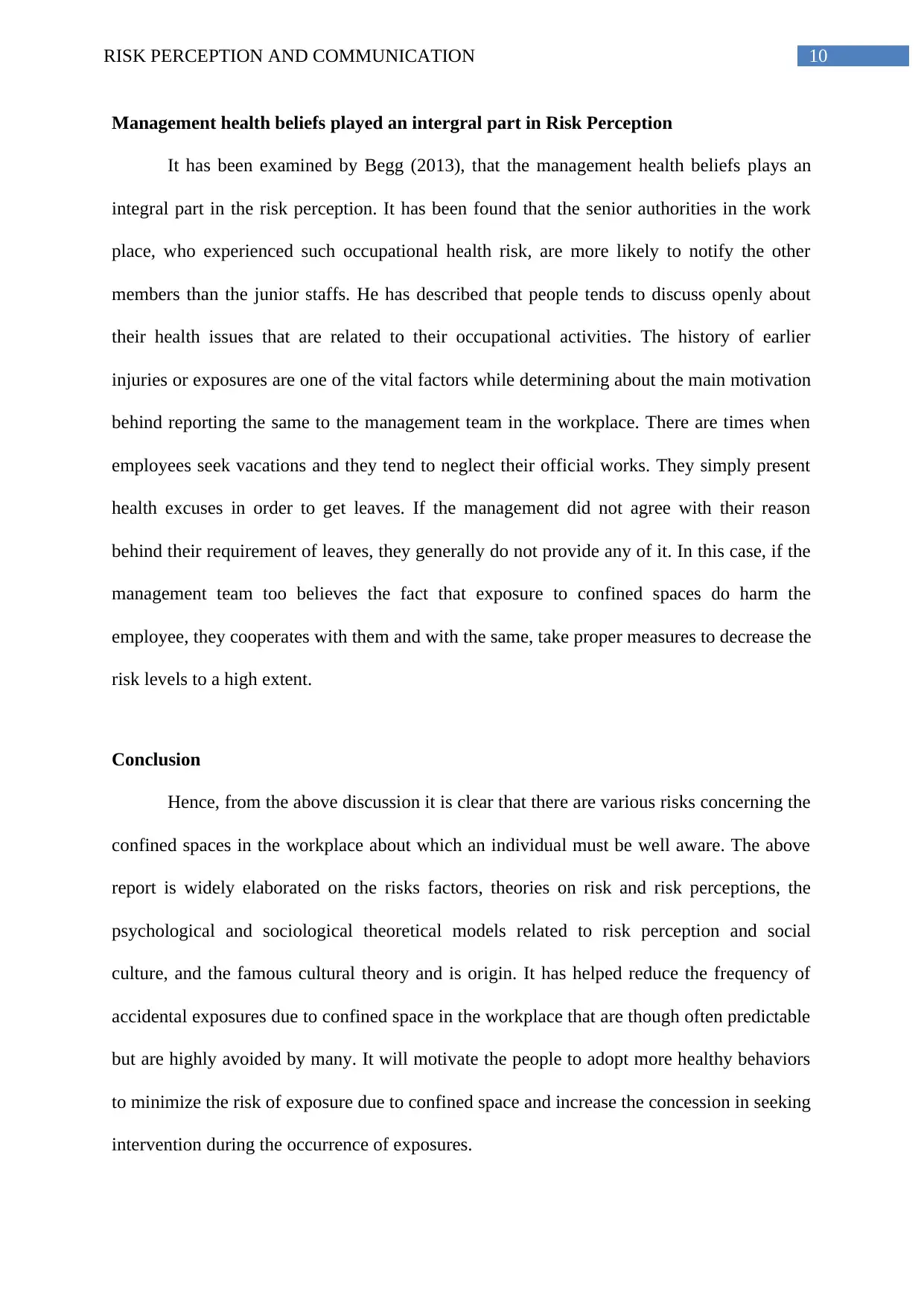
10RISK PERCEPTION AND COMMUNICATION
Management health beliefs played an intergral part in Risk Perception
It has been examined by Begg (2013), that the management health beliefs plays an
integral part in the risk perception. It has been found that the senior authorities in the work
place, who experienced such occupational health risk, are more likely to notify the other
members than the junior staffs. He has described that people tends to discuss openly about
their health issues that are related to their occupational activities. The history of earlier
injuries or exposures are one of the vital factors while determining about the main motivation
behind reporting the same to the management team in the workplace. There are times when
employees seek vacations and they tend to neglect their official works. They simply present
health excuses in order to get leaves. If the management did not agree with their reason
behind their requirement of leaves, they generally do not provide any of it. In this case, if the
management team too believes the fact that exposure to confined spaces do harm the
employee, they cooperates with them and with the same, take proper measures to decrease the
risk levels to a high extent.
Conclusion
Hence, from the above discussion it is clear that there are various risks concerning the
confined spaces in the workplace about which an individual must be well aware. The above
report is widely elaborated on the risks factors, theories on risk and risk perceptions, the
psychological and sociological theoretical models related to risk perception and social
culture, and the famous cultural theory and is origin. It has helped reduce the frequency of
accidental exposures due to confined space in the workplace that are though often predictable
but are highly avoided by many. It will motivate the people to adopt more healthy behaviors
to minimize the risk of exposure due to confined space and increase the concession in seeking
intervention during the occurrence of exposures.
Management health beliefs played an intergral part in Risk Perception
It has been examined by Begg (2013), that the management health beliefs plays an
integral part in the risk perception. It has been found that the senior authorities in the work
place, who experienced such occupational health risk, are more likely to notify the other
members than the junior staffs. He has described that people tends to discuss openly about
their health issues that are related to their occupational activities. The history of earlier
injuries or exposures are one of the vital factors while determining about the main motivation
behind reporting the same to the management team in the workplace. There are times when
employees seek vacations and they tend to neglect their official works. They simply present
health excuses in order to get leaves. If the management did not agree with their reason
behind their requirement of leaves, they generally do not provide any of it. In this case, if the
management team too believes the fact that exposure to confined spaces do harm the
employee, they cooperates with them and with the same, take proper measures to decrease the
risk levels to a high extent.
Conclusion
Hence, from the above discussion it is clear that there are various risks concerning the
confined spaces in the workplace about which an individual must be well aware. The above
report is widely elaborated on the risks factors, theories on risk and risk perceptions, the
psychological and sociological theoretical models related to risk perception and social
culture, and the famous cultural theory and is origin. It has helped reduce the frequency of
accidental exposures due to confined space in the workplace that are though often predictable
but are highly avoided by many. It will motivate the people to adopt more healthy behaviors
to minimize the risk of exposure due to confined space and increase the concession in seeking
intervention during the occurrence of exposures.
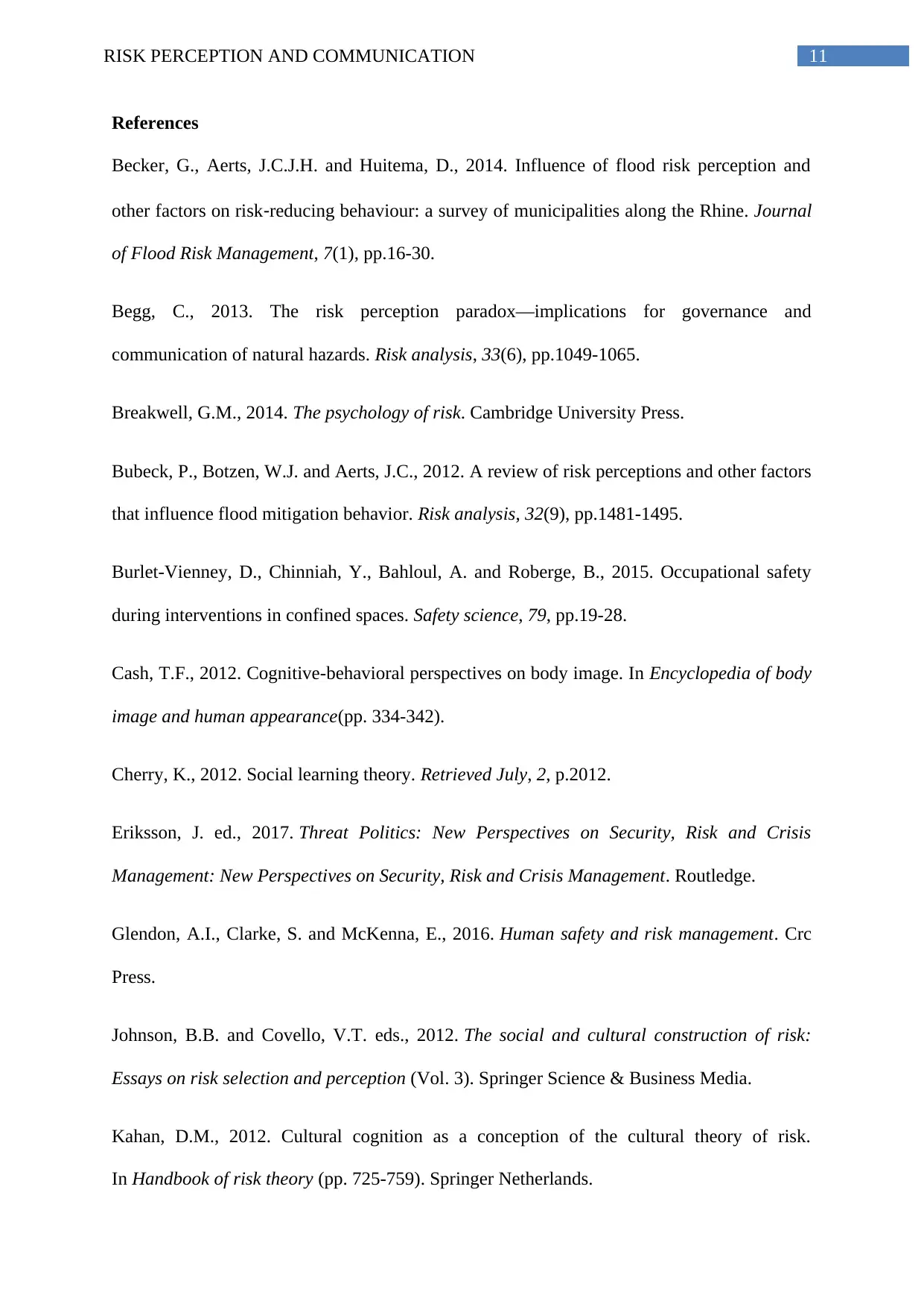
11RISK PERCEPTION AND COMMUNICATION
References
Becker, G., Aerts, J.C.J.H. and Huitema, D., 2014. Influence of flood risk perception and
other factors on risk‐reducing behaviour: a survey of municipalities along the Rhine. Journal
of Flood Risk Management, 7(1), pp.16-30.
Begg, C., 2013. The risk perception paradox—implications for governance and
communication of natural hazards. Risk analysis, 33(6), pp.1049-1065.
Breakwell, G.M., 2014. The psychology of risk. Cambridge University Press.
Bubeck, P., Botzen, W.J. and Aerts, J.C., 2012. A review of risk perceptions and other factors
that influence flood mitigation behavior. Risk analysis, 32(9), pp.1481-1495.
Burlet-Vienney, D., Chinniah, Y., Bahloul, A. and Roberge, B., 2015. Occupational safety
during interventions in confined spaces. Safety science, 79, pp.19-28.
Cash, T.F., 2012. Cognitive-behavioral perspectives on body image. In Encyclopedia of body
image and human appearance(pp. 334-342).
Cherry, K., 2012. Social learning theory. Retrieved July, 2, p.2012.
Eriksson, J. ed., 2017. Threat Politics: New Perspectives on Security, Risk and Crisis
Management: New Perspectives on Security, Risk and Crisis Management. Routledge.
Glendon, A.I., Clarke, S. and McKenna, E., 2016. Human safety and risk management. Crc
Press.
Johnson, B.B. and Covello, V.T. eds., 2012. The social and cultural construction of risk:
Essays on risk selection and perception (Vol. 3). Springer Science & Business Media.
Kahan, D.M., 2012. Cultural cognition as a conception of the cultural theory of risk.
In Handbook of risk theory (pp. 725-759). Springer Netherlands.
References
Becker, G., Aerts, J.C.J.H. and Huitema, D., 2014. Influence of flood risk perception and
other factors on risk‐reducing behaviour: a survey of municipalities along the Rhine. Journal
of Flood Risk Management, 7(1), pp.16-30.
Begg, C., 2013. The risk perception paradox—implications for governance and
communication of natural hazards. Risk analysis, 33(6), pp.1049-1065.
Breakwell, G.M., 2014. The psychology of risk. Cambridge University Press.
Bubeck, P., Botzen, W.J. and Aerts, J.C., 2012. A review of risk perceptions and other factors
that influence flood mitigation behavior. Risk analysis, 32(9), pp.1481-1495.
Burlet-Vienney, D., Chinniah, Y., Bahloul, A. and Roberge, B., 2015. Occupational safety
during interventions in confined spaces. Safety science, 79, pp.19-28.
Cash, T.F., 2012. Cognitive-behavioral perspectives on body image. In Encyclopedia of body
image and human appearance(pp. 334-342).
Cherry, K., 2012. Social learning theory. Retrieved July, 2, p.2012.
Eriksson, J. ed., 2017. Threat Politics: New Perspectives on Security, Risk and Crisis
Management: New Perspectives on Security, Risk and Crisis Management. Routledge.
Glendon, A.I., Clarke, S. and McKenna, E., 2016. Human safety and risk management. Crc
Press.
Johnson, B.B. and Covello, V.T. eds., 2012. The social and cultural construction of risk:
Essays on risk selection and perception (Vol. 3). Springer Science & Business Media.
Kahan, D.M., 2012. Cultural cognition as a conception of the cultural theory of risk.
In Handbook of risk theory (pp. 725-759). Springer Netherlands.
⊘ This is a preview!⊘
Do you want full access?
Subscribe today to unlock all pages.

Trusted by 1+ million students worldwide
1 out of 14
Related Documents
Your All-in-One AI-Powered Toolkit for Academic Success.
+13062052269
info@desklib.com
Available 24*7 on WhatsApp / Email
![[object Object]](/_next/static/media/star-bottom.7253800d.svg)
Unlock your academic potential
Copyright © 2020–2025 A2Z Services. All Rights Reserved. Developed and managed by ZUCOL.





